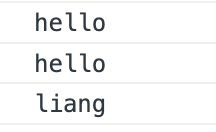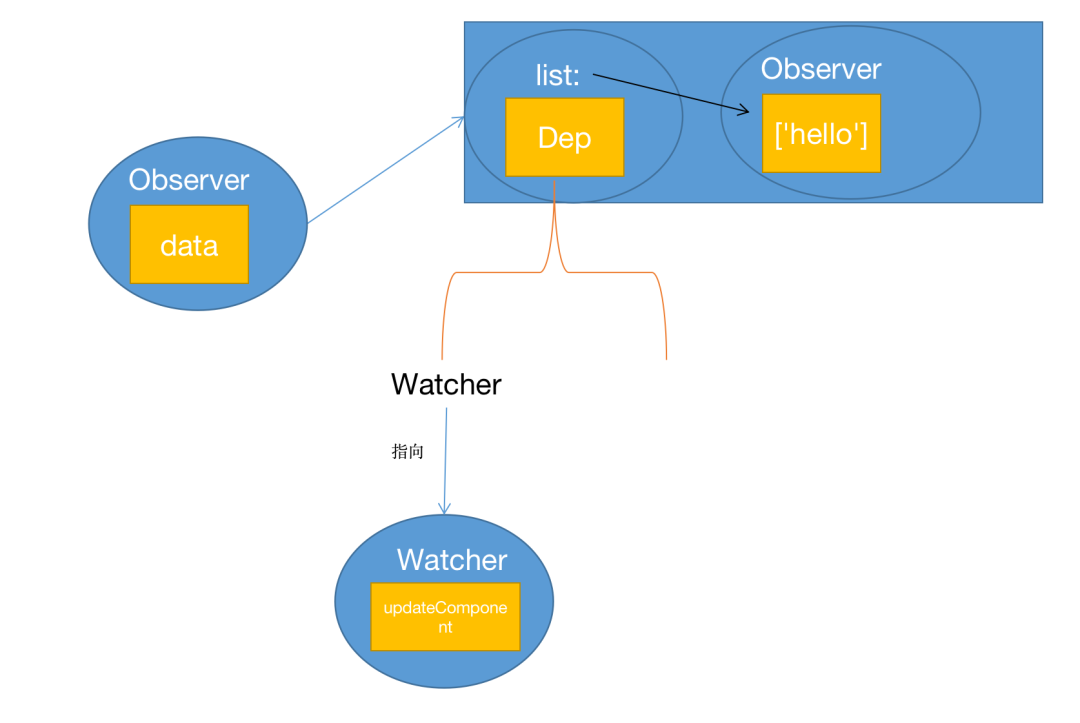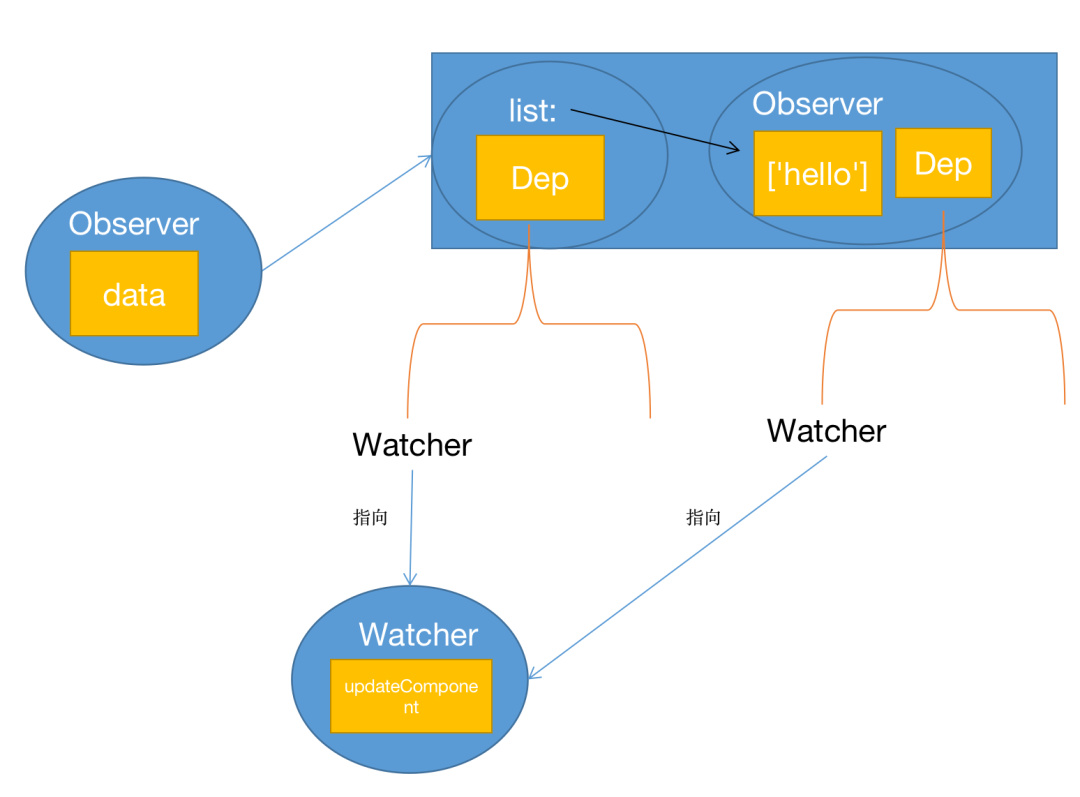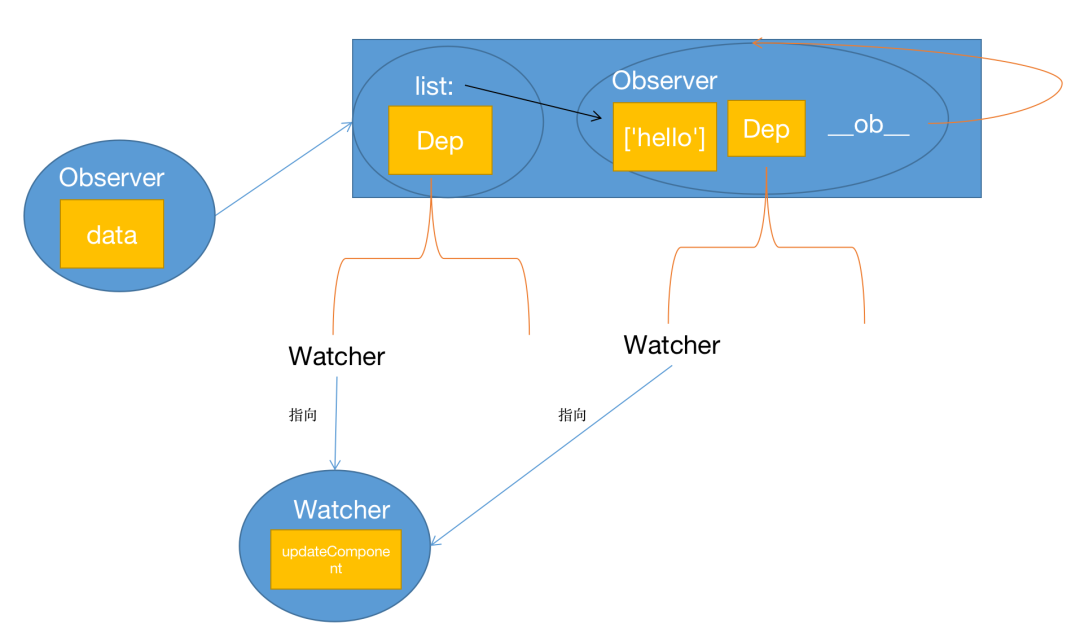Vue2剥丝抽茧-响应式系统之数组
场景
import { observe } from "./reactive";
import Watcher from "./watcher";
const data = {
list: ["hello"],
};
observe(data);
const updateComponent = () => {
for (const item of data.list) {
console.log(item);
}
};
new Watcher(updateComponent);
data.list = ["hello", "liang"];先可以一分钟思考下会输出什么。
... ...
虽然 list 的值是数组,但我们是对 data.list 进行整体赋值,所以依旧会触发 data.list 的 set ,触发 Watcher 进行重新执行,输出如下:

场景 2
import { observe } from "./reactive";
import Watcher from "./watcher";
const data = {
list: ["hello"],
};
observe(data);
const updateComponent = () => {
for (const item of data.list) {
console.log(item);
}
};
new Watcher(updateComponent);
data.list.push("liang");先可以一分钟思考下会输出什么。
... ...
这次是调用 push 方法,但我们对 push 方法什么都没做,因此就不会触发 Watcher 了。
方案
为了让 push 还有数组的其他方法也生效,我们需要去重写它们,通过 代理模式,我们可以将数组的原方法先保存起来,然后执行,并且加上自己额外的操作。
/*
* not type checking this file because flow doesn't play well with
* dynamically accessing methods on Array prototype
*/
/*
export function def(obj, key, val, enumerable) {
Object.defineProperty(obj, key, {
value: val,
enumerable: !!enumerable,
writable: true,
configurable: true,
});
}
*/
import { def } from "./util";
const arrayProto = Array.prototype;
export const arrayMethods = Object.create(arrayProto);
const methodsToPatch = [
"push",
"pop",
"shift",
"unshift",
"splice",
"sort",
"reverse",
];
/**
* Intercept mutating methods and emit events
*/
methodsToPatch.forEach(function (method) {
// cache original method
const original = arrayProto[method];
def(arrayMethods, method, function mutator(...args) {
const result = original.apply(this, args);
/*****************这里相当于调用了对象 set 需要通知 watcher ************************/
// 待补充
/**************************************************************************** */
return result;
});
});
当调用了数组的 push 或者其他方法,就相当于我们之前重写属性的 set ,上边待补充的地方需要做的就是通知 dep 中的 Watcher 。
export function defineReactive(obj, key, val, shallow) {
const property = Object.getOwnPropertyDescriptor(obj, key);
// 读取用户可能自己定义了的 get、set
const getter = property && property.get;
const setter = property && property.set;
// val 没有传进来话进行手动赋值
if ((!getter || setter) && arguments.length === 2) {
val = obj[key];
}
const dep = new Dep(); // 持有一个 Dep 对象,用来保存所有依赖于该变量的 Watcher
let childOb = !shallow && observe(val);
Object.defineProperty(obj, key, {
enumerable: true,
configurable: true,
get: function reactiveGetter() {
const value = getter ? getter.call(obj) : val;
if (Dep.target) {
dep.depend();
}
return value;
},
set: function reactiveSetter(newVal) {
const value = getter ? getter.call(obj) : val;
if (setter) {
setter.call(obj, newVal);
} else {
val = newVal;
}
dep.notify();
},
});
}如上边的代码,之前的 dep 是通过闭包,每一个属性都有一个各自的 dep ,负责收集 Watcher 和通知 Watcher 。
那么对于数组的话,我们的 dep 放到哪里比较简单呢?
回忆一下现在的结构。
const data = {
list: ["hello"],
};
observe(data);
const updateComponent = () => {
for (const item of data.list) {
console.log(item);
}
};
new Watcher(updateComponent);上边的代码执行过后会是下图的结构。

list 属性在闭包中拥有了 Dep 属性,通过 new Watcher ,收集到了包含 updateCompnent 函数的 Watcher。
同时因为 list 的 value ["hello"] 是数组,也就是对象,通过上篇 响应式系统之深度响应 我们知道,它也会去调用 Observer 函数。
那么,我是不是在 Observer 中也加一个 Dep 就可以了。

这样当我们调用数组方法去修改 ['hello'] 的值的时候,去通知 Observer 中的 Dep 就可以了。
收集依赖代码实现
按照上边的思路,完善一下 Observer 类。
export class Observer {
constructor(value) {
/******新增 *************************/
this.dep = new Dep();
/************************************/
this.walk(value);
}
/**
* 遍历对象所有的属性,调用 defineReactive
* 拦截对象属性的 get 和 set 方法
*/
walk(obj) {
const keys = Object.keys(obj);
for (let i = 0; i < keys.length; i++) {
defineReactive(obj, keys[i]);
}
}
}然后在 get 中,当前 Oberver 中的 dep 也去收集依赖。
export function defineReactive(obj, key, val, shallow) {
const property = Object.getOwnPropertyDescriptor(obj, key);
// 读取用户可能自己定义了的 get、set
const getter = property && property.get;
const setter = property && property.set;
// val 没有传进来话进行手动赋值
if ((!getter || setter) && arguments.length === 2) {
val = obj[key];
}
const dep = new Dep(); // 持有一个 Dep 对象,用来保存所有依赖于该变量的 Watcher
let childOb = !shallow && observe(val);
Object.defineProperty(obj, key, {
enumerable: true,
configurable: true,
get: function reactiveGetter() {
const value = getter ? getter.call(obj) : val;
if (Dep.target) {
dep.depend();
/******新增 *************************/
if (childOb) {
// 当前 value 是数组,去收集依赖
if (Array.isArray(value)) {
childOb.dep.depend();
}
}
/************************************/
}
return value;
},
set: function reactiveSetter(newVal) {
const value = getter ? getter.call(obj) : val;
if (setter) {
setter.call(obj, newVal);
} else {
val = newVal;
}
dep.notify();
},
});
}通知依赖代码实现
我们已经重写了 array 方法,但直接覆盖全局的 arrray 方法肯定是不好的,我们可以在 Observer 类中去操作,如果当前 value 是数组,就去拦截它的 array 方法。
这里就回到 js 的原型链上了,我们可以通过浏览器自带的 __proto__ ,将当前对象的原型指向我们重写过的方法即可。
考虑兼容性的问题,如果 __proto__ 不存在,我们直接将重写过的方法复制给当前对象即可。
import { arrayMethods } from './array' // 上边重写的所有数组方法
/* export const hasProto = "__proto__" in {}; */
export class Observer {
constructor(value) {
this.dep = new Dep();
/******新增 *************************/
if (Array.isArray(value)) {
if (hasProto) {
protoAugment(value, arrayMethods);
} else {
copyAugment(value, arrayMethods, arrayKeys);
}
/************************************/
} else {
this.walk(value);
}
}
/**
* 遍历对象所有的属性,调用 defineReactive
* 拦截对象属性的 get 和 set 方法
*/
walk(obj) {
const keys = Object.keys(obj);
for (let i = 0; i < keys.length; i++) {
defineReactive(obj, keys[i]);
}
}
}
/**
* Augment a target Object or Array by intercepting
* the prototype chain using __proto__
*/
function protoAugment(target, src) {
/* eslint-disable no-proto */
target.__proto__ = src;
/* eslint-enable no-proto */
}
/**
* Augment a target Object or Array by defining
* hidden properties.
*/
/* istanbul ignore next */
function copyAugment(target, src, keys) {
for (let i = 0, l = keys.length; i < l; i++) {
const key = keys[i];
def(target, key, src[key]);
}
}还需要考虑一点,数组方法中我们只能拿到 value 值,那么怎么拿到 value 对应的 Observer 呢。
我们只需要在 Observe 类中,增加一个属性来指向自身即可。
export class Observer {
constructor(value) {
this.dep = new Dep();
/******新增 *************************/
def(value, '__ob__', this)
/************************************/
if (Array.isArray(value)) {
if (hasProto) {
protoAugment(value, arrayMethods);
} else {
copyAugment(value, arrayMethods, arrayKeys);
}
} else {
this.walk(value);
}
}
...
}回到最开始重写的 array 方法中,只需要从 __ob__ 中拿到 Dep 去通知 Watcher 即可。
/*
* not type checking this file because flow doesn't play well with
* dynamically accessing methods on Array prototype
*/
import { def } from "./util";
const arrayProto = Array.prototype;
export const arrayMethods = Object.create(arrayProto);
const methodsToPatch = [
"push",
"pop",
"shift",
"unshift",
"splice",
"sort",
"reverse",
];
/**
* Intercept mutating methods and emit events
*/
methodsToPatch.forEach(function (method) {
// cache original method
const original = arrayProto[method];
def(arrayMethods, method, function mutator(...args) {
const result = original.apply(this, args);
/*****************这里相当于调用了对象 set 需要通知 watcher ************************/
const ob = this.__ob__;
// notify change
ob.dep.notify();
/**************************************************************************** */
return result;
});
});
测试
import { observe } from "./reactive";
import Watcher from "./watcher";
const data = {
list: ["hello"],
};
observe(data);
const updateComponent = () => {
for (const item of data.list) {
console.log(item);
}
};
new Watcher(updateComponent);
data.list.push("liang");这样当调用 push 方法的时候,就会触发相应的 Watcher 来执行 updateComponent 函数了。
当前的依赖就变成了下边的样子:

总结
对于数组的响应式我们解决了三个问题,依赖放在哪里、收集依赖和通知依赖。
我们来和普通对象属性进行一下对比。

相关文章
- 【解决方案】浅谈基于边缘计算的智慧工地解决方案
- 软件测试|K8S 容器编排
- 【解决方案】危化安全生产企业智能算法调研
- 行人跟踪浅析
- 广域铭岛参编《重点工业行业碳达峰碳中和需求洞察报告(2022年)》已正式发布
- Mobileye上市:一场迟来的「救赎」
- 软件测试|connection-reset-by-peer问题定位
- 拉拢昔日对手、1499美元的Meta Quest Pro……扎克伯格努力「说服」你加入元宇宙
- 【每日要闻】华为BG、运营商业务最新人事变动;马斯克开卖「烧焦头发」味香水
- 「拯救地球」实验成功!小行星偏离轨道,运行周期缩短32分钟
- 基于不同操作系统升级知行之桥的常见问题
- 【每日要闻】台积电三季度净利大涨79.7%;RTX 4090首发即遭黄牛疯炒
- 大众牵手地平线, 下一步反攻特斯拉?
- ONNXRUNTIEM版本升级到1.13的大坑
- 轻松学Pytorch之Deeplabv3推理
- 十种主流模型C++部署演示
- Tesseract-OCR本文结构与旋转分析,识别字符白名单配置
- 初识下一代云原生网关 Higress
- 本人开发 | 零代码从模型训练到部署软件平台发布啦!
- 软件测试|Dubbo 接口测试原理及多种方法

